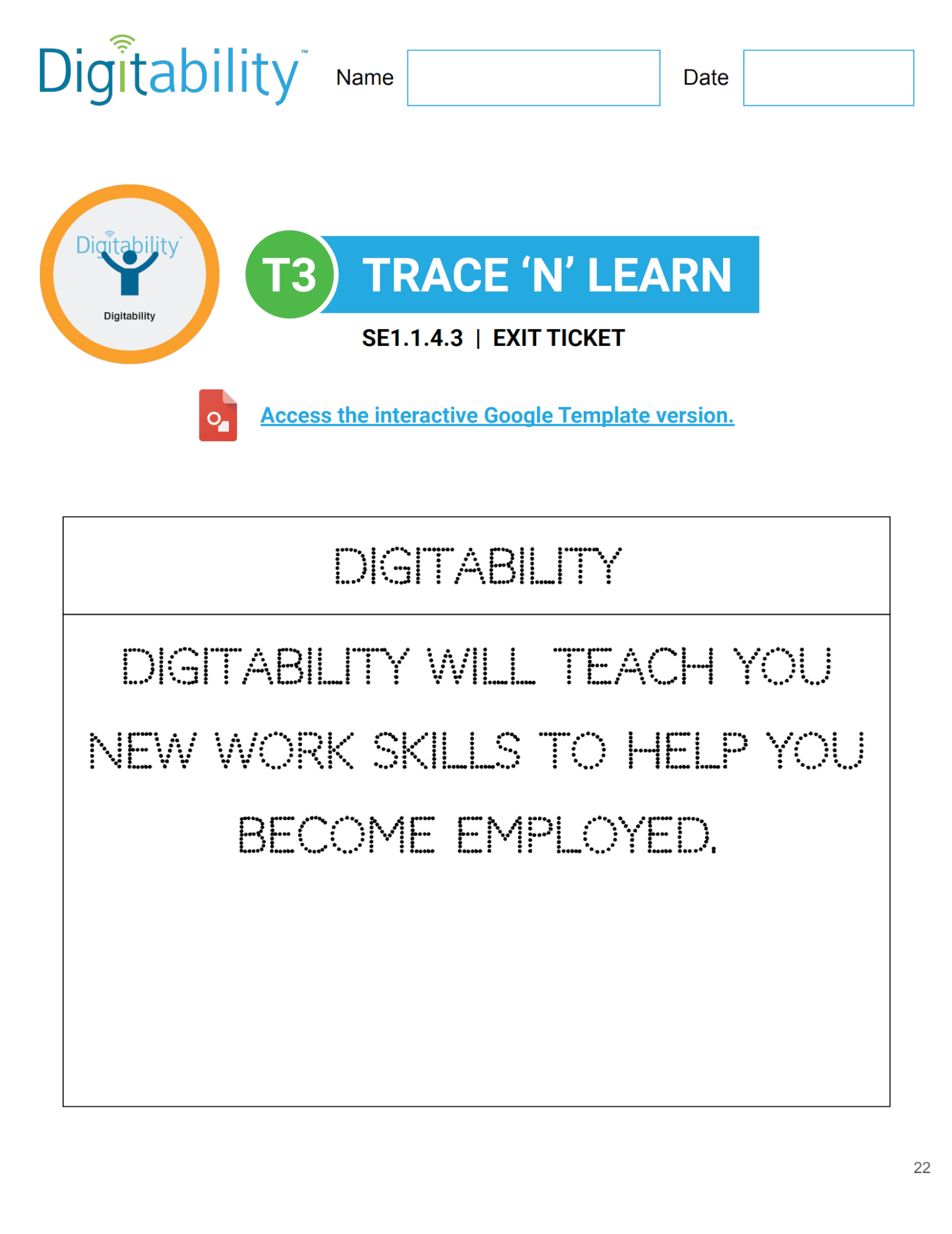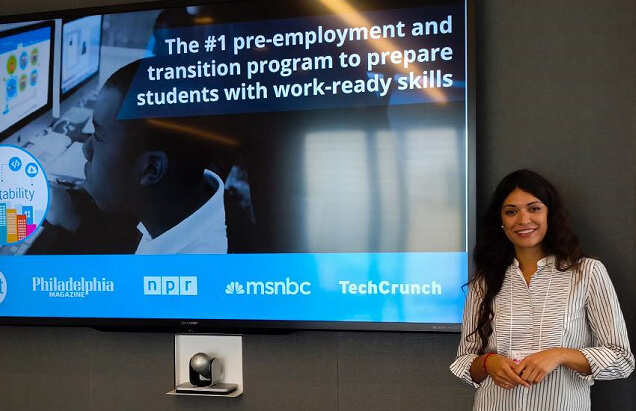Modifying Instruction During Exit Ticket Part 1
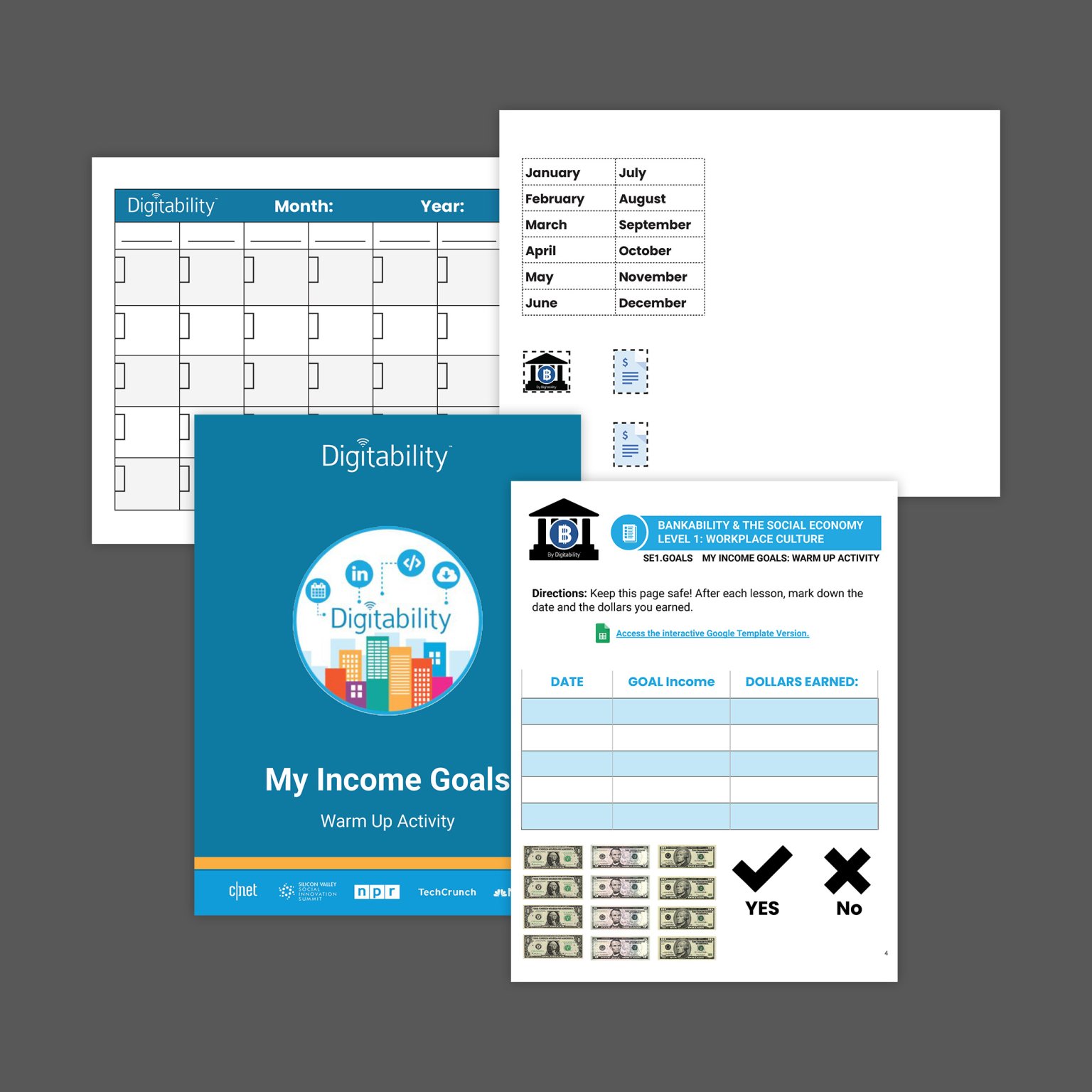
No Two Students are the Same; Neither are their IEP Goals
Each student requires something different when it comes to their list of IEP goals. Every day teachers are charged with finding ways to engage, support, motivate and differentiate for each of their students.
Digitability has organized strategies for streamline evidence-based practices for any given classroom with a wide-range of student needs including varying cognitive abilities, expressive and receptive language, self-regulation skills, and age-appropriate behavior. It’s a tall order for life skills teachers to manage.
Get Your FREE Quote Today!
Overview of the Exit Ticket Part 1
During the Exit Ticket (and throughout instruction), teachers use differentiation strategies and leveled resources, which are included in each lesson plan, to increase expressive and receptive language based on individual student needs.
In Part 1 of the Exit Ticket, students will be given a worksheet to complete that will allow them to demonstrate their learning from that day’s lesson. The Supplemental Materials section of each lesson plan contains three differentiated versions of the Exit Ticket Activity.
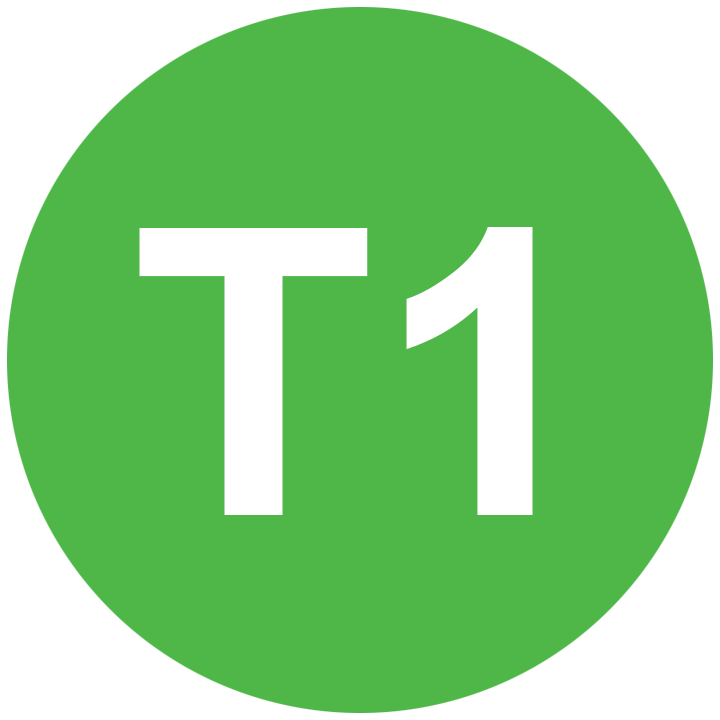
Exit Ticket T1 is a resource that asks students to write a paragraph using the lesson’s vocabulary word. With the vocabulary paragraph, students are expected to describe what the vocabulary word is, how it could be used in the workplace, and include examples.
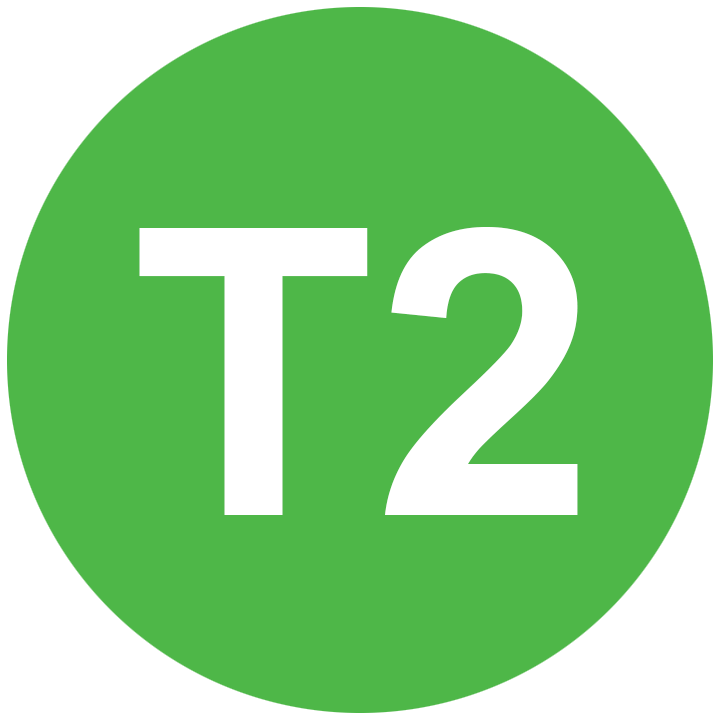
Exit Ticket T2 is a resource that asks students to complete a vocabulary block for the key word from that lesson. In the vocabulary block, students will define the word, use it in a sentence, include an example, and draw or attach a picture.

Exit Ticket T3 is a resource that allows students to trace the vocabulary word and the definition. Each of these supports are designed to meet students at their level so that all students can be meaningfully included in the Exit Ticket.

Using a timer to increase time on task attendance: When students are completing the Exit Ticket, the teacher will set a timer and tell students if they complete their Exit Ticket within the given time frame, they will earn two Participation Dollars. However, if they complete it after the timer has gone off, they will only earn one Participation Dollar. This creates an incentive for students to complete their time bound task.
Meet the Student Personas
Note: The following personas are meant to illustrate a range of cognitive, communicative and behavioral needs for a wide-range of learning styles. These personas were created to help teachers identify the characteristics and associated strategies for their students needs.

Advanced Tier 1 Student: Drew can read, write, and comprehend paragraphs. Academically, he is one year below grade level. He is reinforced by getting time to use his phone during school. Drew has low motivation to complete assignments. He has difficulty with self-regulation and responsible decision making. He also has difficulty with impulse control. Drew is charismatic and his peers are drawn to him, giving him the potential to be a leader.

Tier 1 Student: Marcus can speak in 2-3 sentences and is able to read and comprehend paragraphs. He is reinforced by watching videos on Youtube. Marcus’ behaviors that impede learning include interrupting and complaining. He consistently is helpful with other students in the class and is a strong problem solver.

Tier 2 Student: Abbey can speak in 4-5 word utterances, and she is able to read with little comprehension. Abbey is reinforced by listening to music. She has some behaviors that interfere with learning, such as making off topic comments and teasing others. Abbey tends to perseverate on fairies and princesses, which contributes to her off topic comments. However, Abbey is an active participant in lessons and frequently shares with her peers.

Tier 3 Student: Jonathan is primarily nonverbal, he uses a communication device inconsistently, and knows some signs. He is not yet reading and has limited listening comprehension. Jonathan is reinforced by playing computer games. He demonstrates behaviors that interfere with learning, such as aggressive behavior and not following directions. However, Jonathan consistently greets others and likes to participate in lessons.
Strategies for an Advanced Tier 1 Student

Advanced Tier 1 Student:
Functional Academics: Can read, write, and comprehend paragraphs; Academically, he is one year below grade level.
Language: Age-appropriate
Reinforcers: Time to use his phone during school
Behavior: Low motivation to complete assignments. Difficulty with self-regulation and difficulty with impulse control.
Strengths: Charismatic and his peers are drawn to him, giving him the potential to be a leader.
During the Exit Ticket Part 1: To complete Exit Ticket Part 1, Drew should be given the T1 resource, which is the vocabulary paragraph. Because Drew has strong reading comprehension skills, this resource will best support his learning. He can either complete this resource as a printed worksheet or on a Google Doc template that is linked in the lesson plan. Drew may write the minimum amount required. The teacher should prompt him to expand his sentences and give him specific feedback using the TAG Writing Rubric. Using the rubric, the teacher can also assign next steps for Drew to complete.
Strategies for Extending Responses
- As the teacher is reviewing Drew’s paragraph, the teacher may provide feedback that his paragraph needs more details.
- The teacher could begin by identifying a strength by telling Drew that he has a nice clear topic sentence, but that he does not have sufficient examples included in his paragraph. Using the rubric, the teacher can see that next steps for Drew would be revising his paragraph for homework and including at least three supporting details.
- Drew may be resistant to adding more to his paragraph. The teacher should remind Drew of the reinforcement contingency to build his motivation to write more. “Drew, I like that you got started. I can give you more dollars for writing some more details. You can use your dollars to earn cell phone time!”
- The teacher may brainstorm with Drew to get him started and give him some ideas. For example, “Drew, let’s think of some more details about the internet. Where do you use it? What do you do on the internet?”
- Any time Drew extends his response, the teacher should provide immediate feedback using the embedded Digitability language formulas.
repeat the answer + describe the behavior + deliver consequence
"Drew is adding more details to his vocabulary paragraph in the designated time, great job earning a Participation Dollar!"
In Level 2 of Digitability's Workplace Behavior Unit, students will identify and practice both the behaviors that will support their success in the workplace, as well as those behaviors that can be perceived as problematic. In these lesson plans, Digitability will explicitly explain how complaining impacts the workplace and depict strategies for developing self-regulation skills and a self-advocacy plan. In this level of Digitability, the teacher can utilize the Social Economy to assign a $1 fee for complaining to help Drew analyze the frequency of this behavior and strengthen his strategies for self-regulation. To learn more, contact our team.

What is an Extinction Burst? It is important to understand that with some interventions the behaviors may seem to increase in frequency, intensity or duration before they begin to decrease. This is called an extinction burst. Evidence-based practices embedded in Digitability's Social Economy are tools that should be used consistently in order to be effective. It won't be a one-and-done solution!
Strategies for a Tier 1 Student

Tier 1 Student:
Functional Academics: Can read and comprehend paragraphs
Language: Can speak in 2-3 sentences
Reinforcers: Watching videos on Youtube
Behavior: Interrupting and Complaining
Strengths: Consistently helpful with other students, strong problem solver
During the Exit Ticket Part 1: Marcus should be given the T1 resource, which is the vocabulary paragraph. Because Marcus has reading and comprehension skills, this resource will best support his learning. Marcus can either complete the paragraph as a printed worksheet, or on a Google Doc template that is linked in the lesson plan. This gives Marcus the opportunity to either write or type his response.The TAG Writing Rubric can be used to provide Marcus with specific feedback on his writing. While completing his paragraph, Marcus may use materials inappropriately. He may take his pencil and throw it across the room and crumple up his paper.
Strategies for Addressing Inappropriate Use of Materials
- By throwing his pencil and crumpling his paper, Marcus could be trying to gain attention and/or avoiding the task. To address this behavior, the teacher should be sure to follow through with the demand and pay as little attention as possible to the problematic behavior.
- “Marcus, please go pick up your pencil and un-crumple your paper. Can you remind me what you’d like to purchase with your Participation Dollars? To earn that time on Youtube, you need to have enough dollars. You can earn dollars by doing your Exit Ticket. Let’s try again.”
- Once back on task, Marcus may require additional prompting to ensure that his paragraph is comprehensive. The teacher may tell Marcus that his paragraph has many great examples that relate back to the topic, however, he has four mechanics errors. Using the rubric, the teacher can see that next steps for Marcus in this area could be for him to fix those errors for homework that evening.


Marcus may need additional prompting to ensure that all parts of his paragraph are included. The teacher can give a verbal prompt by telling him “Remember, your paragraph needs to have the definition, how it applies to the workplace, and examples.” The teacher can also give a visual prompt by providing a list or visuals of those three components that must be included in the paragraph.
- When Marcus completes his paragraph, including all areas that are necessary, the teacher should provide immediate feedback using the embedded Digitability language formulas.
repeat the answer + describe the behavior + deliver consequence
"Marcus finished his vocabulary paragraph in the designated time, great job earning a Participation Dollar!"
- In Level 2 of Digitability's Workplace Behavior Unit, students will identify and practice more behaviors in the workplace that will support their success in the workplace as well as those behaviors that can be perceived as problematic. In these lesson plans, Digitability will explicitly explain how complaining impacts the workplace and strategies for developing self-regulation skills and self-advocacy plans for the workplace. To learn more, contact our team.
Strategies for a Tier 2 Student

Tier 2 Student:
Functional Academics: Can read with little comprehension, some writing skills, low IQ
Language: Speaks in 4-5 word utterances
Reinforcers: Listening to music
Behavior: Making off-topic comments due to perseverating on fairies and princesses, teasing others
Strengths: Actively participates in lessons, frequently shares with peers
During the Exit Ticket Part 1:. Abbey can be given the T2 resource, which is the vocabulary block. Because Abbey has some reading and little comprehension skills, this resource will allow her to organize the information in a simpler, more meaningful way, as compared to a paragraph. She can either complete the vocabulary block as a printed worksheet, or on the Google Template that is linked in the lesson plan. This gives Abbey the opportunity to either write or type and draw her responses. However, as Abbey is working, she elopes from the classroom.
Strategies for Addressing Elopement
- As long as it is safe to do so, the teacher should follow Abbey at a distance, without engaging in a chase. A support staff should remain in the room and continue the lesson. If that is not possible, follow your school’s protocol for elopement.
- The teacher should pay minimal attention to Abbey while she is eloping. With minimal verbalizations, the teacher can point or gesture in the direction of the classroom while showing a visual of a Participation Dollar to remind her of the reinforcement that is available to her when she is in the classroom.
- Once Abbey begins to return to the classroom, the teacher can give her positive feedback by saying “Great choice walking back to the classroom, Abbey. Once we are back, you can work for Participation Dollars that you can use to buy time to listen to music.”
- Once Abbey returns to the classroom and is ready to begin her work again, the teacher will need to prompt her through completing her Exit Ticket.
- Abbey should be able to refer to resources such as the Word Wall and lesson video while completing her Exit Ticket. The teacher can prompt Abbey toward these resources by gesturing or verbally telling her to check these to support her response.
- If Abbey is having difficulty with completing the vocabulary block, the teacher can make the demand lesser by scribing for Abbey. The teacher could either write or type the responses that Abbey provides. Then, Abbey can copy them. This allows Abbey to focus on providing a response first, and then writing or typing her response second.

The teacher can prompt Abbey to expand on her response by providing verbal prompts, such as “An example of something you can do on the internet is…”
- When Abbey completes her vocabulary block, the teacher should provide immediate feedback using the embedded Digitability language formulas.
repeat the answer + describe the behavior + deliver consequence
"Abbey finished her vocabulary block in the designated time, great job earning a Participation Dollar!"
- In Level 2 of Digitability's Workplace Behavior Unit, students will identify and practice more behaviors in the workplace that will support their success in the workplace as well as those behaviors that can be perceived as problematic. In these lesson plans, Digitability will explicitly explain how complaining impacts the workplace and strategies for developing self-regulation skills and self-advocacy plans for the workplace. To learn more, contact our team.
Strategies for a Tier 3 Student

Tier 3 Student:
Functional Academics: Not yet reading, limited listening comprehension, low IQ
Language: Primarily nonverbal, uses a communication device inconsistently, knows some signs
Reinforcers: Playing computer games
Behavior: Aggressive behavior, not following directions
Strengths: Consistently greets other, enjoys participating in lessons
During the Exit Ticket Part 1: Jonathan can be given the T3 resource, which is the Trace N’ Learn. Because Jonathan has limited reading and listening comprehension, this resource will allow him to actively participate by tracing the word and the definition. He can either complete the Trace N’ Learn as a printed worksheet, or on the Google Template that is linked in the lesson plan. This gives Jonathan the opportunity to either write or type and draw his responses. Jonathan may not complete his Exit Ticket by the deadline set by the teacher and instead may be off-task by engaging in self-stimulatory behavior by rocking back and forth in his seat and not completing his work.
Strategies for Addressing Off-Task Behavior
- If Jonathan is off-task, the teacher can provide verbal, visual, and gestural reminders to return to task. The teacher can give a verbal reminder of the expected behavior while gesturing toward the Exit Ticket. The teacher can also show the visual that shows Participation Dollars equals playing computer games.
- However, if Jonathan continues to engage in self-stimulatory behavior, the teacher can remind him of the workplace deadline. “Jonathan, remember, if you finish your work by the time the timer goes off you’ll earn 2 Participation Dollars. If not you can try again, but only for 1 Participation Dollar.”
- When the timer goes off, if Jonathan is not finished, the teacher can tell him, “Jonathan, you did not finish your work by the deadline. I will extend your deadline by 2 more minutes. You can still have the opportunity to earn one Participation Dollar if you finish it in the next two minutes."

The teacher should set another 2 minute timer and remind him of the reinforcement contingency. “If you finish it in two minutes, you’ll earn a Participation Dollar, which you can use toward buying computer game time.”
- When Jonathan completes his Trace N’ Learn, the teacher should provide immediate feedback using the embedded Digitability language formulas.
repeat the answer + describe the behavior + deliver consequence
"Jonathan finished his Exit Ticket, great job earning a Participation Dollar!"
- In Level 2 of Digitability's Workplace Behavior Unit, students will identify and practice more behaviors in the workplace that will support their success in the workplace as well as those behaviors that can be perceived as problematic. In these lesson plans, Digitability will explicitly explain how complaining impacts the workplace and strategies for developing self-regulation skills and self-advocacy plans for the workplace. To learn more, contact our team.
If you need additional resources or assistance in differentiation, reach out to your coach!


